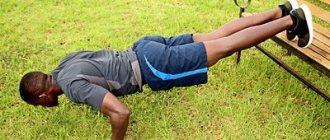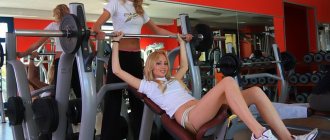Starting to practice yoga on your own is not as difficult as it seems at first glance. This sport is now very popular and fashionable, as it allows you to put in order not only your body, but also your thoughts. Many techniques and levels of difficulty of asanas allow you to choose the appropriate option for any purpose. But to get at least minimal results, you need to not just watch the video, but start practicing on your own.
Types of yoga for beginners
- Ashtanga. An energetic and intense look that will not let you relax. One lesson consists of several poses lasting five breathing cycles. Between them, a “sun salutation” must be done.
- Mysore. The safest variety. The average duration is 3 hours, but you can come and go as you please, take breaks, and maintain your own pace, not the instructor’s pace. The demonstrated asanas can be repeated as many times as required.
- Vinyasa flow. Just business, no unnecessary information about the muscle groups that work, the benefits, effects, designations of asanas. This is a complete immersion in the inner world, as well as high intensity exercise.
- Bikras. This species was created in the 70s of the last century. It consists of exactly 26 asanas that strengthen muscles, develop body stretching, and compress internal organs. In order to get rid of toxins, the air in the room is heated (sauna effect). Therefore, you will have to work hard.
- Kundalini. The basis of this knowledge is working with the spine, its restoration, and support. Traditional asanas are complemented by breathing practices and meditation.
- Hatha. No meditations, mantras, breathing techniques, only physical activity through asanas.
- Yin. An excellent option for those people who lead a sedentary lifestyle or do not move much. The yin variety relieves tightness and stiffness in the muscles, increases flexibility and elasticity. The duration of one asana can be up to 10 minutes. Thanks to meditation, this type is often chosen by athletes before serious competitions.
- Jivamukti. Includes reading, listening to special musical compositions, doing vinyasa poses, and singing. This direction is considered a separate philosophy that allows you to get rid of unnecessary things.
All types are aimed at relaxation, getting rid of stress, gaining knowledge and skills to understand your body. But some focus on stretching, others on posture and back health, and strength exercises. You must first understand why you should start doing yoga in order to choose a specific type and focus completely on it.
Yoga for the spine for beginners
It is difficult to find a person who has never experienced back problems. This is due to sedentary work, a sedentary lifestyle, regular carrying of heavy objects, an uncomfortable mattress - to each their own. We bet you're sitting slouched even now? Quickly straighten your back and try to perform the following set of asanas for the spine at home.
Shalabhasana (“Locust Pose”). Lie on your stomach with your chin on the floor as far as possible. Hands along the body. As you exhale, lift your legs, arms and head at the same time. Squeeze your buttocks. Stay in this position for 5–8 breathing cycles (inhale–exhale). Yoga is for the patient, so you need to have endurance.
Bitilasana (Cat Pose). Get on all fours, spread your legs hip-width apart. Arms are straight, palms are located under the shoulders. Relax your neck, look at the floor. As you inhale, lift your pelvis and chest up, while your stomach drops down. Straighten your head, look straight ahead. As you exhale, return to the starting position, starting from the lower back. The asana should be repeated 10–15 times.
Yastikasana (“Cane Pose”). Lie on your back. Place your arms behind your head; they should remain straight. Lower your chin forward. Relax your body and, as you inhale, gently stretch your arms and legs from the center to the extremities. Stay in this pose for about 10 seconds, then relax your muscles. Repeat the asana 3-6 times.
Is it possible to learn yoga on your own?
According to experienced experts, if there is no opportunity or desire to visit the gym, you can always practice at home. You just need to select asanas that will match your experience and not jeopardize your health. If you have no experience at all, you can attend several classes with an instructor to understand the structure of the classes and the features of a particular direction.
While practicing at home, do not forget about a number of recommendations and rules that will help you do everything right and constantly develop your body and thoughts.
- Safety comes first. Many exercises are quite traumatic; you need to start with the simplest basics with detailed video tutorials. Only if the body completely gives in, and the position of the legs and arms is learned, can you move on to the next stage.
- You can't do without a warm-up. As in any sport, proper warm-up allows you to warm up your muscles and joints and prepare them for stress. Warm-up should include exercises for all muscle groups.
- It is better to do yoga on an empty stomach. That is why the morning time or two hours after breakfast is suitable. Due to compression of the organs, the body may reject undigested food.
- Contraindications. If there are inflammatory processes, open wounds, infectious diseases, acute respiratory viral infections, exacerbation of chronic diseases, menstrual periods or stomach pain, you should postpone classes until next time.
- Stable schedule. You cannot start yoga classes on your own, and then take a break for two months and continue from the same place again. The body forgets about its achievements. If you are interrupted, you need to start from scratch. Create a schedule that is convenient for you and follow it constantly. For example, it is better to study every other day for half an hour than just twice a week for three hours.
In addition, it is important not to forget about moderation. You should not try asanas shown by trained bloggers or experienced athletes if they are of a difficult level. Everything has its time: beginners should learn at least 20 simple asanas and meditation in order to move on.
Tips and rules for organizing home yoga classes
- When practicing yoga at home, be sure to make sure that the room is warm and free of drafts, since you should not freeze while practicing yoga. This is due to the fact that in a cold room it is more difficult for muscles and ligaments to warm up, which leads to incorrect and less effective exercises, as well as the risk of spraining ligaments and muscles.
- To conduct a yoga complex at home, take care of complete silence and tranquility; nothing should distract or irritate you. If you are blinded by bright light, you can put a blindfold on your eyes; if there is still extraneous noise, you can insert earplugs into your ears.
- When performing asanas, especially if you are doing it for the first time, do not try to bring the poses to perfection through pain; at the initial stage they can be performed with incomplete amplitude. This will reduce the risk of injury, and will also gradually prepare the ligaments, joints and muscles for the final position. The main thing in yoga is perseverance and patience; mistakes will be corrected as you master the technique.
- Start the exercise only in the absence of physical or psychological stress; you should feel cheerful and in a relaxed state. If you are depressed or worried about something, do savasana, the so-called corpse pose. In which you need to achieve maximum relaxation and drive away all disturbing thoughts. By the way, you can end a yoga class with an asana like shavasana.
- Of course, in the initial stages of home yoga, you need to learn how to perform asanas correctly, but do not forget about relaxation and even and continuous breathing.
- In the intervals between asanas, relax those muscles as much as possible, since when performing a certain asana, muscle contraction occurs, which should subsequently be replaced by relaxation, for example in shavasana. A minute's rest will be enough during which you relax your muscles and perform several calm breathing cycles, which will also restore your heartbeat.
- Try to perform asanas at a slow pace, balancing and maintaining balance, movements should be as smooth as possible. However, make sure that the body remains stable and does not sway from side to side.
- Be sure to start your home yoga class with the mindset that you will succeed. Choose a few simple asanas that you can master with ease and practice them each time, honing your technique. With each new workout, try to perform the asanas more deeply and stay in this position a little longer than the last time, this way you can develop your body more effectively.
- Each asana should be performed at a slow pace, going through three stages: entering the asana, staying in a fixed position, and returning to the starting position. Do not try to quickly enter the final position of the asana; slowly and gradually first master its intermediate positions.
- While you are doing yoga training at home, try to avoid rushing and if you have already started the lesson at a measured, rather slow pace, then bring the workout to the end without trying to finish it quickly. If, nevertheless, time does not wait, in this case, reduce the training not by increasing the speed of the exercises, but by reducing their number. You can also reduce the number of repetitions of each asana, but you should not reduce the time spent in one or another asana.
- When conducting yoga training at home, try to concentrate your attention on what you are doing, and not fly with your thoughts in the clouds; when performing each stage of the asana, your attention should be concentrated on movement and correct, calm breathing.
- Only after you have completely mastered the initial, non-complex asanas and your body has acquired sufficient flexibility, can you move on to more complex asanas, which should also be mastered gradually. You can hold difficult asanas in the first stages for a few seconds, increasing the time spent in it with each training session. However, when you begin to master complex yoga exercises, you should not forget about the initial asanas that you have already mastered; for you at this stage they are the most effective, while you are just beginning to master complex poses.
- When you have reached the final position of the exercise, hold it for as long as possible, while remaining motionless. If you have performed the asanas correctly and are relaxed in both your thoughts and body, then after completing the practice you should feel good and light. If, while in a pose, you feel anxiety or discomfort, then leave the asana without delay.
- After you have lingered in the final position of the asana, begin to slowly exit the pose, just as when entering the asana, return to the starting position at a very slow pace.
- Repeat each asana 4-6 times; if you are already able to follow the technique of performing and holding the asana, the number of repetitions can be reduced.
- However, performing asanas is not the last thing you should learn; one of the main points in yoga is mastering the correct breathing technique (pranayama) and mastering meditation, which should end each yoga session. Read about this in our next articles.
- It is better to do yoga on an empty stomach, therefore, for home yoga, early in the morning immediately after waking up is suitable, this will also allow you to practice with a fresh mind without having heavy thoughts and experiences that can accumulate during the day. If you nevertheless decide to practice during the day or in the evening, then you should conduct a home yoga workout no earlier than 2-4 hours after eating. Before practicing yoga, you should drink some water, green tea or natural juice, and you can also allow yourself a couple of sips of warm milk. Between performing asanas, you can also drink a couple of sips of water.
- After classes, you should not engage in vigorous activities; you should also take a shower before, and not after, yoga classes. This is due to the fact that during yoga exercises, long-term changes in blood circulation occur in the body, which should gradually return to normal functioning.
Where to start at home?
There are a number of recommendations and steps that will help you quickly and easily start learning yoga at home.
- Choose a place to practice. You need to be in complete harmony with yourself in order to practice. Therefore, everything around should bring peace, and not irritate. This could be in the bedroom near the bed, in the corner of the living room or even on the balcony. The main thing is that there are no distractions. Choose a seat near a window with plenty of natural light.
- Arrangement of the place. First of all, you need to purchase a special mat for yoga classes. It can be made of synthetic, natural, or combined materials, and must be suitable in size. There should be no furniture around the chosen place that could cause injury. Over time, the corner can be decorated with photographs, cute things, and motivational images. Other activity accessories can be purchased later when needed. These include a meditation blanket, knee pads, smart sports sensors with a timer and the ability to control pressure, pulse, and body temperature.
- Drawing up a nutrition plan and training schedule. It is compiled taking into account work, family, sleep patterns, etc. There are no clear boundaries when you can and cannot exercise. The main thing is that it is comfortable for the body and does not cause stress. The meal schedule is also selected based on the time of classes.
- Choice of style. There are a lot of them, options for beginners have already been mentioned. Before choosing, you should read about the purpose of each type, what advantages, features, and whether it will help achieve a specific goal. There is no need to rush, since further development depends on the first direction. Information is available in specialized books and websites. But it is best to contact a professional instructor at the club. Most often, beginners prefer Ashtanga and Hatha yoga, which are considered the simplest and safest.
- Choice of exercises. Even after choosing a specific type of practice, several dozen asanas are offered, which differ greatly from each other. Building a program on your own is difficult, but possible. In addition, there are special mobile applications that greatly simplify this task. You can also ask your coach for advice.
- Select music or background. It is believed that it is better to concentrate in silence. But that's not true. The sounds of a house, apartment, neighbors, street, and even drops of water from a tap can throw you off balance. A special selection of music for relaxation allows you to forget about extraneous sounds and focus on a certain rhythm and tempo. In addition, some compositions help achieve peace of mind.
Yoga as a way of life is pleasure and balance. If it leads to irritation, pain, or other problems of a physical or moral nature, you need to change direction or even choose a completely different sports activity. And if after training there are only good impressions, the vector of movement has been chosen correctly.
What do you need to have to practice yoga at home?
And so you decided to practice yoga at home, it’s good that you need to purchase a special yoga mat for practicing, it will help make your home classes more comfortable and convenient. If you don’t have a rug, it doesn’t matter, you can do without it. You will also need a blanket; you probably have a warm blanket at home that will keep you warm during meditation and relaxation.
Later, when you master the initial asanas in yoga, you will need two blocks and a yoga belt, but in the first stages you can do without them. Also, what is useful for yoga, whether you are a beginner or have already encountered more complex asanas, you need comfortable clothes that will not hinder movement, it is better if it is clothes made from natural fabrics, which will allow you to get even closer to complete comfort. As you can see, to practice yoga at home, you need very few available tools and a lot of desire and perseverance.
Breath
Breath control is fundamental to any practice. It should be calm, deep, rhythmic. Inhalations and exhalations are made full, measured, with intervals between cycles. Beginners are advised to use a metronome to set the desired tempo. At first you will have to constantly monitor your breathing, but then it will return to normal. If you skip this stage and do asanas as best you can, then there will be no effect. Even leisurely yoga in hammocks, without breathing, is just gymnastics.
Warm-up
Warming up before asanas is somewhat different from the standard one. The first part is more like a regular exercise for all muscle groups. But towards the end, the movements become smoother and calmer. The purpose of a warm-up is to first warm up the muscles so that they begin to work, and then calm them down. Already at this stage you need to use correct breathing. To relax between warm-up and asanas, you can use meditation, learning mantras, and calm music.
Simple asanas that you can do yourself
- Simple basics. Everything in yoga originates from it. Beginners need to sit on the mat with their legs stretched out in front of them. Place each foot under the opposite knee. Bend your lower back slightly forward, straighten your back. This base is used for breathing, meditation and other asanas.
- Rock. Also applies to the main ones. You need to sit on your knees and put your hands on your hips. The back remains straight. Your ankles will hurt first, so you can put a blanket under your buttocks.
- Mountain. Stand straight, feet shoulder-width apart, lower back and stomach tense and straight. Shoulders and chest are straightened. As you inhale, your hands rise up and touch your fingers and continue to stretch. The stand should be firm and not wobble.
- Triangle pose, better known as downward-facing dog. From a standing position with your arms and legs shoulder-width apart, move to resting your feet and palms on the floor. All limbs are straight, the neck is elongated, the back is as straight as possible. The body should form a triangle. The initial duration is one minute, but ideally the asana should last at least 4 minutes.
- Cat-cow pose. The initial pose is on all fours. Place your hands shoulder-width apart and your knees under your hips. As you inhale, begin to pull your pelvis forward, smoothly bending your back down. The chin stretches as high as possible. This is the cow pose from which you need to move into the cat pose. To do this, as you exhale, you need to start moving your pelvis, your back in the opposite direction, and rest your chin on your chest.
- "Cobra". An excellent asana for training your shoulders and chest. Lie on your stomach, place your hands under your shoulders. Slowly raise your head, neck, and chest until your arms are fully straightened. In this case, the body should move backward. If at first it is difficult to hold on to your outstretched arms, you can slightly bend your elbows. Hold the pose for 1 to 3 minutes.
- "Tree". Another basic asana that everyone should learn. Starting in Mountain Pose, lift one leg and place the sole of the foot on the thigh of the other leg. Pull your stomach in, straighten your back, raise your arms up and join them with your palms. Hold this for several breathing cycles. Repeat for the other leg.
These are just a few asanas that make up the basic framework of yoga. It will take a lot of time to master them, since they only seem easy at first glance. In addition, you need to constantly monitor not only your movements, but also your breathing.
What is the practice?
Everyone has heard the word “yoga” at least once in their life. But will everyone be able to clearly explain what it is? Yoga is an amazing practice that came to the world from mysterious India, bringing health to the body and soul of a person. Yoga will teach you how to breathe and relax correctly, improve your blood pressure, and help you forget about insomnia.
One of the most popular poses is Vrikshasana (tree pose)
If we talk about yoga in the full meaning of the word, then it is a special way of life that helps to achieve enlightenment. This is the oldest philosophical doctrine about the essence of human life.
Anyone who decides to seriously engage in yoga must be aware that living according to the new canons will require a lot of time for this serious hobby, and it will be necessary to give up some of the benefits of civilization.
Yoga will make you rethink your life principles and habits. It will require immediate renunciation of everything harmful and bad. A person must instill control over his feelings, acquire mental and physical balance. Independence from one’s feelings, the ability to meditate and fully concentrate one’s attention lead to the achievement of perfection of the human soul.
If you perceive yoga as a set of asanas (special poses), then it will become just gymnastics, nothing more. But it will not bring the desired effect. In this case, yoga is a set of various exercises to improve health, normalize the functioning of individual organs, and form a perfect figure.
Find out tips from professionals on how to do the splits at home.
A set of exercises for losing weight at home. https://stroy-telo.com/domashnij-trening/fitness-dlya-pohudeniya/kompleks-uprazhnenij-dlya-pokhudeniya-doma-kak-pokhudet-v-domashnikh-usloviyakh.html
Here are recommendations on how to do Pilates at home.
How did it appear?
The history of yoga is long and rich. Even on Indian seals dating back to the 2nd-3rd centuries BC. e., there are images of figures in yoga meditation poses. This concept is found in the Rig Veda - in the ancient Upanishad, which scientists date back to the 10th century BC. e. The basic concept of yoga is outlined in the “middle” Upanishads of the 6th century BC. e. These are the Mahabharata, Bhagavad Gita and also the Yoga Sutra.
The earliest school was called "Raja Yoga". It is also called “Mind Control Yoga”. The Yoga Sutra defines “Ashtanga Yoga” - the eight steps of “Raja Yoga”.
These steps are divided into two main parts:
- the four lowest stages are “Hatha Yoga”;
- the four highest stages are “Raja Yoga” itself.
It is “Hatha Yoga”, which is focused on cleansing the body and mind of a person, increasing vital energy, that has become widespread in the world.
When should you go to a yoga center?
Yoga classes in St. Petersburg are now very well attended and popular, so finding an option that is in harmony with your inner state is quite easy. There is plenty to choose from. If home lessons do not give any results, self-discipline is poor, it is better to go to an instructor with professional training and study in a group. The support of other athletes and the opportunity to quickly learn will improve not only your mood, but also the level of your body’s preparation for new asanas. The body will respond to regular, well-constructed exercises with progress. The result will become more noticeable, which will encourage you and give you hope to become an advanced yogi.
Contraindications to yoga
Avoid practicing yoga, especially at home, if:
- elevated body temperature (above 37 degrees);
- ARVI, acute respiratory infections, as well as general poor health;
- exacerbation of chronic diseases;
- disorders of the cardiovascular system.
You should also not start yoga after active physical activity, after a bath or after drinking alcoholic beverages (at least a day must pass), after suffering severe stress and irritation, as well as in the first 2 days of menstruation.











